4WD Recovery No Winch No Worries

A set of MaxTrax will keep you sane on sand
It's often assumed that any serious four wheeler should be loaded with a powered winch – that's simply not the case. There are a number of factors as to you might be getting out there sans-winch: cost is a big one, the need to fit a new bumper or improve power systems, they can play havoc with a vehicle's weight distribution, perhaps there just aren't enough foreseeable trips to justify it. Whatever the reason, there are plenty of other ways to get your ride out of a sticky situation – it's best to figure out your options before the bottom drops out.
PEOPLE POWER
Some of the simplest things can make a huge difference. First up, get digging. Grab a shovel and clear some space around each bogged wheel. By digging an incline toward the surface in the direction of recovery, you'll dramatically reduce the forces working against you.
If you're up for a bit of a workout, it's possible to use a block and tackle system, securing one end to the vehicle and the other to a fixed point, to haul your vehicle by hand. You'll need to be prepared with some serious snatch blocks, a good length of static rope and some recollection of how pulleys work.
The biggest danger during 4WD recovery occurs when something breaks, so it's important to stand clear when the action is taking place. No matter how strong you think you are, giving the vehicle an extra push or pull won't make the difference between freedom and staying stuck – avoid the urge to step in and lend a bit of grunt and you'll avoid becoming a casualty should anything go awry.
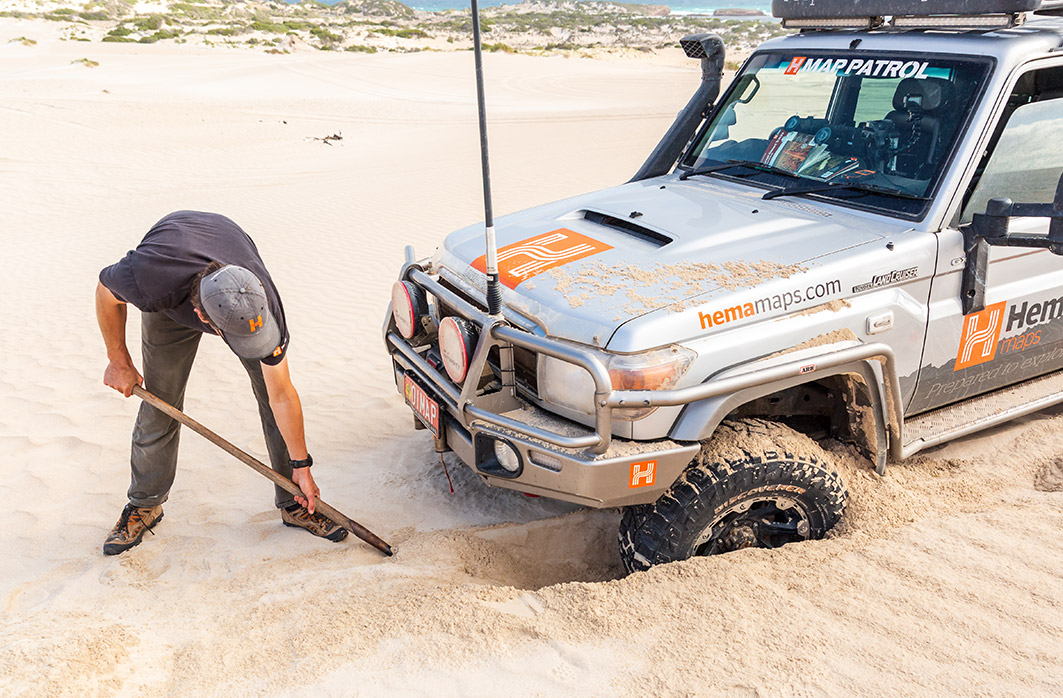 When in doubt, dig it out
When in doubt, dig it out
TRACTION AIDS
It doesn't take a physics degree to realise that when you're stuck, it's usually due to a lack of traction. Often, recovery is simply a matter of getting some grip and driving out of there. If you haven't already done so, lowering tyre pressure can provide just enough additional surface area to get out of a sandy situation – don't forget you'll need an air compressor to pump them back up afterwards.
Traction boards, such as Maxtrax, are a handy, versatile and economical tool for escaping loose ground (and they seem to be in fashion when driving around the city during the week). There are also a number of devices which can attach to a vehicle's wheels that provide a bit of extra bight.
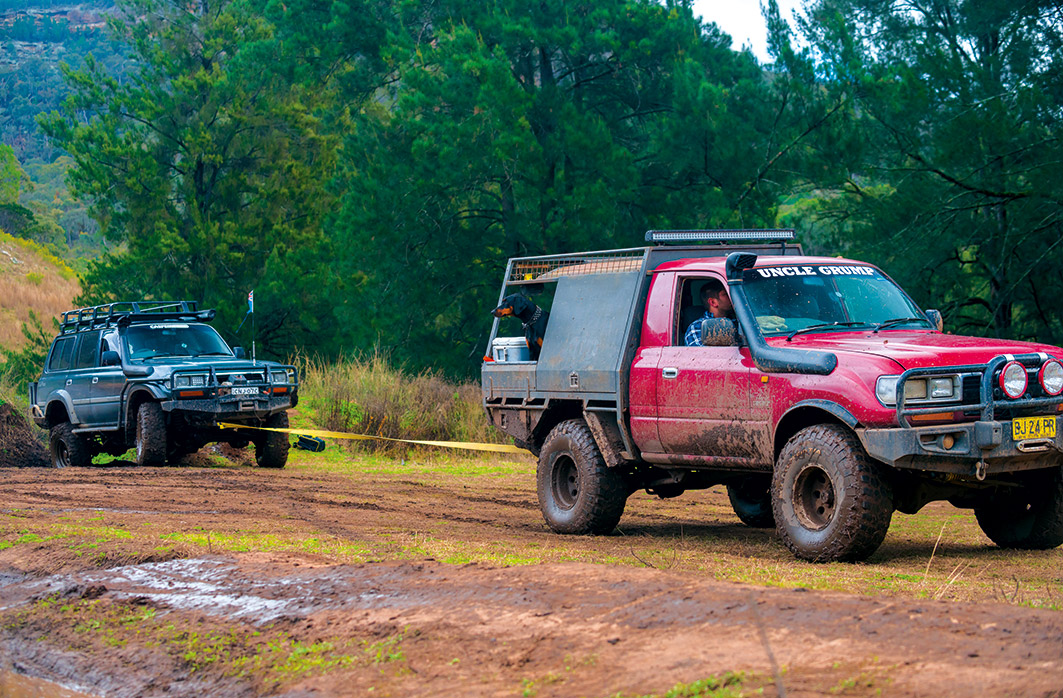
Stay clear of the loaded snatch strap
SNATCH STRAPS
It's always safe to travel with another vehicle, bonus points if your mate has a winch. But if not, never fear; snatch straps are a quick and easy way to get a buried vehicle back in action, although are not suitable for mud as it creates way too much suction. A snatch is a kinetic (or stretchy) piece of bound webbing. It's attached via shackles to a recovery vehicle on one end and the stricken vehicle on the other. When the recovery vehicle moves away, the snatch strap stretches, loads up with kinetic energy and applies that force to pluck the stuck vehicle from its peril.
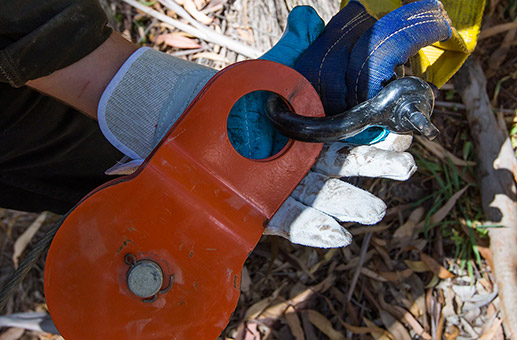 Snatch block, shackle and tree trunk protector
Snatch block, shackle and tree trunk protector
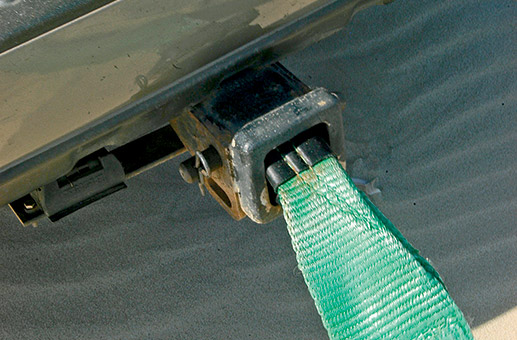
Snatch strap connected to tow-hitch using the hitch pin
It's important to remember that a loaded snatch strap can be dangerous, you need to ensure the gear is up to the task and not damaged in any way. Only use a rated snatch strap attached to rated shackles on proper recovery points. If you don't know where the recovery points are on your vehicle then find out – you'll generally find two at the front and you can use your vehicles tow-hitch using either a hitch receiver or your hitch pin (never use a tow ball). The strap itself should have a minimum breaking strength equivalent to twice the gross vehicle mass (GVM) of the lighter of the two vehicles.
Always be aware that a loaded snatch is potentially very dangerous. Use a dampener and stand clear when they're in use. Never use snatch straps for towing or lifting.
JACKS AND HAND WINCHES
Hand winches have been hauling 4WDs since your granddad was sinking his Series 1 Land Rover. They're an easy piece of gear to have on hand, but they can be a bit of a workout. Essentially, they have a dual-clamping system that alternately locks and pulls on a steel cable, moving it through one crank at a time. Given that this system requires the user to be standing alongside their tensioned cable, it's good remember to use cable dampeners, rated gear and never use dynamic ropes or snatch straps with a winch (chains and cables are the go-to). These devices are built with a fail-safe known as a shear pin, which is designed to be the weakest element and will break before anything else, leaving the cable clamped in place. However, damaged or inappropriate gear will likely still fail first.
Many people favour the Hi-Lift jack over a standard hand winch. Why? Because it's a jack that can winch – two birds with one stone. You'll need a couple of extra jack fittings to do the job properly (most manufacturers of this style jack will offer these as an additional purchase) as well as a drag chain that's at least five metres long. Once it's all rigged up you just crank away.
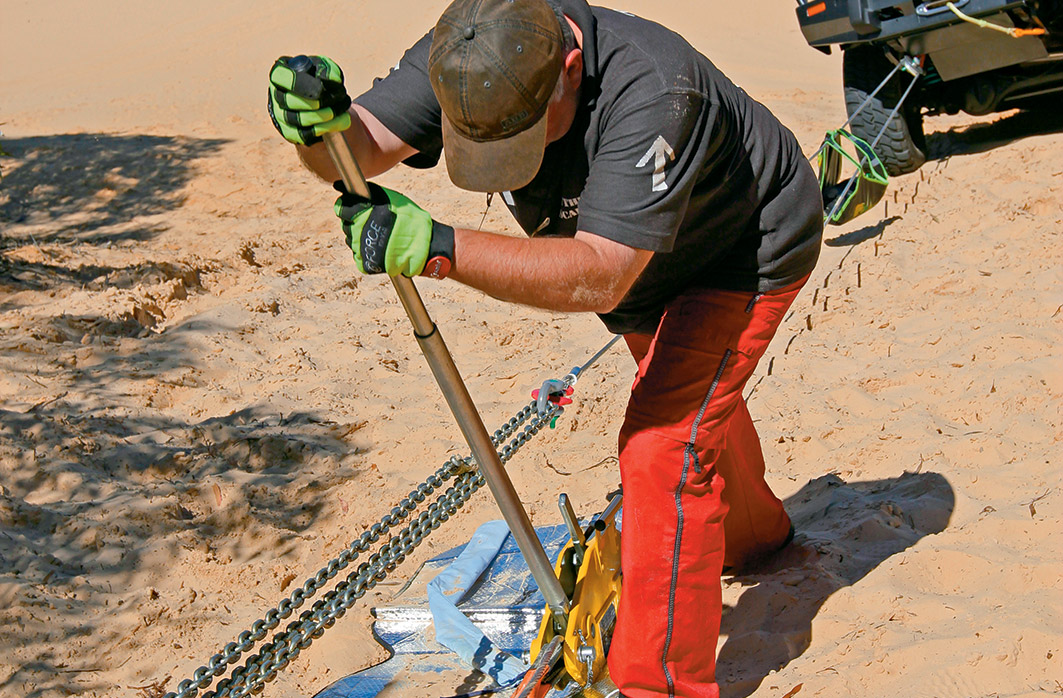 Hand winching and working up a sweat
Hand winching and working up a sweat
Another handy use for the Hi-Lift is something known as jack-casting. This entails jacking the bogged vehicle from the front or back and then pushing it sideways off the jack, thus relocating the wheels and hopefully gaining a better position with enough traction to drive away. It sounds intimidating but it's simple and safe if done properly. The main thing to be conscious of is how the jack will fall once the vehicle is pushed off. If you get this part wrong you can end up piercing panels and doing all kinds of damage.
As you might imagine, there's ultimately no one recovery method that's going to work every time. Even if you did have a powered winch, chances are you'd find yourself snatching and digging more often than reeling out the cable anyway. All it takes is a bit of planning and a little know-how, then you're good to go. You will still have to drop a few of your hard-earned onto some kit, but at a fraction of the price of a burly bumper-mounted winch. But once you've got a good set of gear there's no need to shy away from those bold 4WD adventures you've been dreaming of and leave those chicken tracks behind.









0 comments